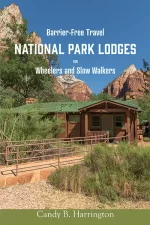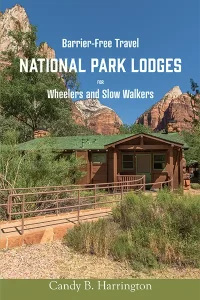There’s no better way to explore our national parks than by car. You can travel at your own pace, stop whenever the spirit moves you, and seek out wheelchair-accessible sites along the way. With that in mind, check out these national park scenic drives that not only offer incredible windshield views, but also pass by accessible trails and overlooks.
Grand Teton National Park — Jenny Lake Scenic Drive
This one-way scenic drive along Jenny Lake begins just south of the turnoff to String Lake, near Jenny Lake Lodge. About halfway along the tree-lined road, you’ll see Jenny Lake Overlook on the right. Don’t pass it up, as the view is magnificent. And although stairs lead to a lower vantage point you can still get a good lake and mountain view from the upper pathway.
Near the end of the scenic drive, there’s also a pullout with an accessible parking space, located next to a service road. If you’d fancy an accessible walk through the forest, then follow this half-mile paved road to the campground, then make a right and head towards the ranger station. From there, you can connect to the accessible portion of the Jenny Lake Trail or head back. And since this trail isn’t listed on any park maps, it’s never very crowded.
Glacier National Park — Going-to-the-Sun Road
Next up on our list of national park scenic drives is Going-to-the-Sun Road in Glacier National Park. This classic drive takes you from from West Glacier, up over Logan Pass and back down to St. Mary at the east end of the park. Open seasonally, it takes about two hours to drive the road straight through; however it’s much more than a utilitarian route, so make a day of it and check out the accessible trails at Logan Pass and the Trail of the Cedars along the way.
The alpine section of Going-to-the-Sun Road — from just north of the Trail of the Cedars to Jackson Lake Overlook — also offers a number of scenic overlooks and wayside exhibits along the way. And don’t miss the Weeping Wall, a series of waterfalls alongside the road, just east of The Loop. This site is most impressive in the early season, when the melting snow adds to the flow, but it slows down and even dries up during the late summer.
Grand Canyon National Park — Desert View Drive
Named after the historic Desert View Watchtower, Desert View Drive runs from the east park gate to the South Entrance Road, with several canyon viewpoints along the way. This section of the park is a good choice for folks who want to ditch the Grand Canyon Village crowds, and enjoy a quieter slice of the canyon.
The iconic Desert View Watchtower, which is located near the East Entrance, is a must-see if you venture along this stretch of the road. The Tusayan Museum is also worth a stop, as it features an accessible quarter-mile trail through an ancient pueblo site. And don’t miss Grandview Point, the most accessible viewpoint along Desert View Drive. Named for the Grand View Hotel which graced this site in the late 1800s, this overlook offers a panoramic view of the Grand Canyon, including several bends in the Colorado River. It is indeed a “grand view”.
Yosemite National Park — Tioga Road
Nest up on our list of national park scenic drives is Tioga Road. This route traverses the north section of Yosemite National Park and connects Crane Flat on the west with Highway 395 on the east. The 39-mile road features some of the most dramatic scenery in the park, as it transitions from forests and meadows to lakes and granite domes, before it crosses Tioga Pass at the 9,945 foot elevation point. That said, winter is harsh in this section of the park, and Tioga Road is not plowed, so this must-do scenic drive is only possible from late spring to fall.
Although the views are spectacular along the length of the drive, Tenaya Lake is the highlight of this route. At 8,150 feet, it’s a true alpine lake, and although there are good windshield views from the road, stop at the rest area on the east side of the lake for a closer look. An accessible asphalt and boardwalk path winds through the forest, crosses a bridge and ends on the lakeshore. There are several picnic tables there, but the accessible one is set on an asphalt pad, while the others are in sand. It’s a pleasant spot to enjoy the view, and it also makes a nice lunch stop.
Crater Lake National Park — Rim Drive
The highlight of any Crater Lake visit is the 31-mile scenic Rim Drive. Although you can drive it straight through in about an hour, allow two-to-three hours, so you can stop at the viewpoints and overlooks along the way. Phantom Ship Overlook is one of the most popular stops, as it offers a good view of a dark jagged island that resembles a ship. Just up the road there’s an unmarked overlook between Cloudcap Overlook and Cleetwood Cove that offers an even better view. And for a good view of Wizard island, be sure and stop at Discovery Point, which has a steep ramp up to the overlook. Don’t fret if you can’t manage the ramp though, as you’ll catch some of the best views of the island from the road.
Once you reach the end of the drive, turn around and take it in the opposite direction. Not only will you get an entirely different view of the lake on the return trip, but you’ll most likely spot some pullouts that weren’t visible from the other direction. Either way, the Rim Drive is one of the most accessible ways to enjoy Crater Lake National Park.
Great Smoky Mountains National Park — Roaring Fork Motor Nature Trail
Last but not least on our list of national park scenic drives is the Roaring Fork Nature Trail in Great Smoky Mountains National Park. Although there are many scenic routes through this popular national park, this drive gets top billing because buses and RVs are prohibited, so it’s a good place to dodge the crowds. It’s easy to find too – just follow Highway 321 east from the Sugarlands Visitor Center, and turn right at Stoplight #8 on Historic Nature Trail. Continue along the road till you hit Cherokee Orchard Road, which will take you to the one-lane Roaring Fork Motor Nature Trail.
This 5.5-mile loop drive winds through the forest and offers a quiet look at the national park. Pick up a brochure at the beginning of the drive to learn more about the history and ecological diversity of the area. The drive begins in a dense hardwood forest filled with chestnuts, oaks, maples and magnolias, then passes 25-foot high Grotto Falls before it transitions into a hemlock forest, passes some historic cabins and ends at the “place of a thousands drips”, which becomes a mini-waterfall in wet weather. It’s a beautiful drive, but plan accordingly it’s closed during the winter. On the other hand, it’s an absolutely gorgeous fall foliage route.

